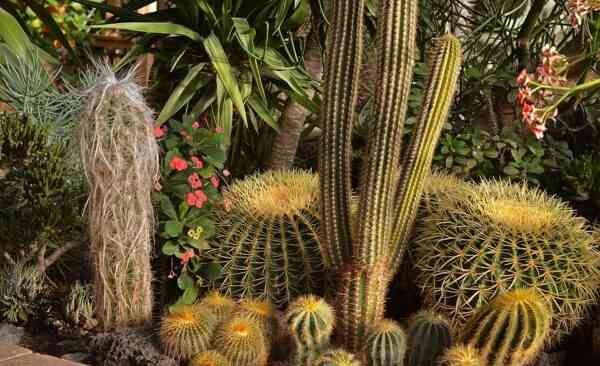Amazing in their diversity, cacti are some of the most interesting plants on earth. Many of them live much longer than humans, patiently waiting for years for favorable conditions to bloom. Due to their beauty and unpretentiousness, many cacti quickly became quite popular as houseplants, although, of course, domestic specimens are difficult to compare with the majestic giants growing in the wild.
Interesting facts about cacti
- The very word «cactus» comes from the ancient Greek «kaktos». The ancient Greeks used it to designate any plants with thorns.
- So far, no fossil remains of cacti have been found, although many fossilized trees have been found (interesting facts about trees).
- Before the discovery of the New World Columbus, Vespucci and other navigators, cacti were unknown to Europeans.
- Cereus cacti growing in California reach a height of 20 meters. It’s about 7 floors. One trunk of such a giant contains about 2 tons of water.
- Columbus himself wrote in his notes that the natives ate strange prickly melons. In fact, he saw how they ate a cactus (interesting facts about Columbus).
- Cacti are also widely used as raw materials. They are used in beverages, soaps, shampoos and livestock feed.
- The tallest cactus ever found has grown to 24 meters and is estimated to be 150 years old. It is still growing, being under the official protection of the state. Authorities promise 25 years in prison for damaging him.
- In the shamanic practices of many Indian peoples in some Latin American countries, hallucinogenic cacti are still used (interesting facts about Latin America).
- Mexican farmers actively feed their cows with prickly pear cacti, which contain a lot of water, as this allows you to increase milk yield. Cows like this food, but it must be cleaned of thorns before feeding the animals, otherwise they may get hurt.
- The smallest cacti in the world are bloomsfeldii. They do not grow more than 3 centimeters.
- In Mexico, slices of a certain type of cactus in sugar are a popular delicacy.
- In Bolivia and Paraguay, some types of cacti have completely disappeared, since they all were eaten clean by the locals (interesting facts about Paraguay).
- Contrary to popular belief, tequila is not made from cacti. The blue agave, which is the raw material for the preparation of this drink, is not a cactus.
- Traditional Argentinean drums are made from the stems of large cacti.
- In some Latin American countries, homeowners plant rows of thorny cacti along the fence for added protection. It is extremely difficult to overcome such a wall.
- The only open-air cactus garden in the world is located in the Principality of Monaco (interesting facts about Monaco).
- Once, prickly pear cacti nearly caused an environmental disaster in Australia. The prickly pear brought to this mainland rapidly captured more and more new spaces, displacing other plants and killing the livestock that ate them with their thorns. The Argentine moth brought for this purpose helped to cope with the cactus invasion. She even erected a monument in Australia.
- Home cacti do not often need to turn the other side to sunlight. This is fraught with weakening of the plant and even falling out of needles.
- In total, there are about 3 thousand species of cacti in the world.
- The aborigines of South America have long used cactus needles for surgical purposes, using them to sew up wounds (interesting facts about South America).
- For unknown reasons, dogs, wolves and their other relatives do not like cacti, and sometimes even fear them , even if you have never personally encountered them.
- Cactus thorns ionize the air no less effectively than the leaves of many plants.
- Donkeys living in South America have got used to knocking down thorns from cacti with their hooves, so that they can then calmly eat the plant. European donkeys don’t know how to do this.
- In Mexico, large cacti are used instead of a Christmas tree (interesting facts about Mexico).
- Thorns replace leaves for cacti, but much less moisture evaporates from them than from flat leaves. Their other function is to protect the plant from animals.
- Bees, butterflies, hummingbirds and even bats are pollinating cacti.
- Most species of cacti can tolerate heat up to +55 without harm to themselves -60 degrees.
- Europe’s first collection of cacti appeared in the 16th century in London, collected by an inquisitive local apothecary.
- 75 to 90 percent of the mass of a cactus is water. The exact value depends on the type of plant and its current moisture supply.
- Cactus roots, unlike tree roots, go only slightly into the ground, which makes them easy to uproot or knock down. But in width they grow significantly in order to absorb moisture from the maximum available area in case of rain.
